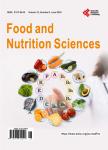Major, Minor and Trace Element Analysis of Baobab Fruit and Seed by Instrumental Neutron Activation Analysis Technique
Major, Minor and Trace Element Analysis of Baobab Fruit and Seed by Instrumental Neutron Activation Analysis Technique作者机构:Department of Nuclear Sciences and Applications School of Nuclear and Allied Sciences University of Ghana Legon Ghana Faculty of Applied Sciences Physics Department University for Development Studies Navrongo Ghana Nuclear Reactors Research Centre National Nuclear Research Institute Ghana Atomic Energy Commission Legon Ghana Nuclear Reactors Research Centre National Nuclear Research Institute Ghana Atomic Energy Commission Legon Ghana Department of Nuclear Sciences and Applications School of Nuclear and Allied Sciences University of Ghana Legon Ghana
出 版 物:《Food and Nutrition Sciences》 (食品与营养科学(英文))
年 卷 期:2013年第4卷第8期
页 面:772-778页
学科分类:1002[医学-临床医学] 100214[医学-肿瘤学] 10[医学]
主 题:Heavy Metals Baobab INAA Potassium Calcium Magnesium
摘 要:Mineral element compositions of Baobab fruit and seed have been determined using Instrumental Neutron Activation Analysis. Total of 18mineral elements were determined of which 10 are not normally reported using other methods. The concentrations of heavy metals were: Arsenic 0.06 and 0.04, Mercury 0.04 and 0.04 Hg and Cadmium 0.08 and 0.04 respectively for the seeds and the fruit. The average concentration of trace elements in the seed were;Aluminium (11.50 μg/g), Barium (17.3 μg/g), Bromine (2.45 μg/g), Cobalt (0.07 μg/g), Copper (28.6 μg/g), Iron (42 μg/g), Iodine (0.04 μg/g), Manganese (17.7 μg/g), Sodium (23.53 μg/g), Vanadium (0.035 μg/g), and Zinc (12.06 μg/g), while the average concentrations of Aluminium (27.74 μg/g), Barium (13.10 μg/g), Bromine (3.01 μg/g), Cobalt (0.08 μg/g), Copper (14.9 μg/g), Iron (26.05 μg/g), Iodine (0.27 μg/g), Manganese (7.05 μg/g), Sodium (52.06 μg/g), Vanadium (0.08 μg/g), and Zinc (0.79 μg/g) were determined for the dried fruit pulp. The mineral concentrations of the baobab fruit and seed were characterized with high concentration of potassium, calcium, magnesium and substantive amount of chlorine [K (21350 μg/g), Ca (3170 μg/g), Mg (2310 μg/g) and Cl (211 μg/g), for the fruit pulp and K (12240 μg/g), Ca (2360 μg/g), Mg (4720 μg/g) and Cl (88.6 μg/g), for the seed]. The fruits and seeds present useful source of mineral needs for the indigenous African community where the trees are found and may be recommended as food supplement due to high content of calcium, magnesium and potassium.



